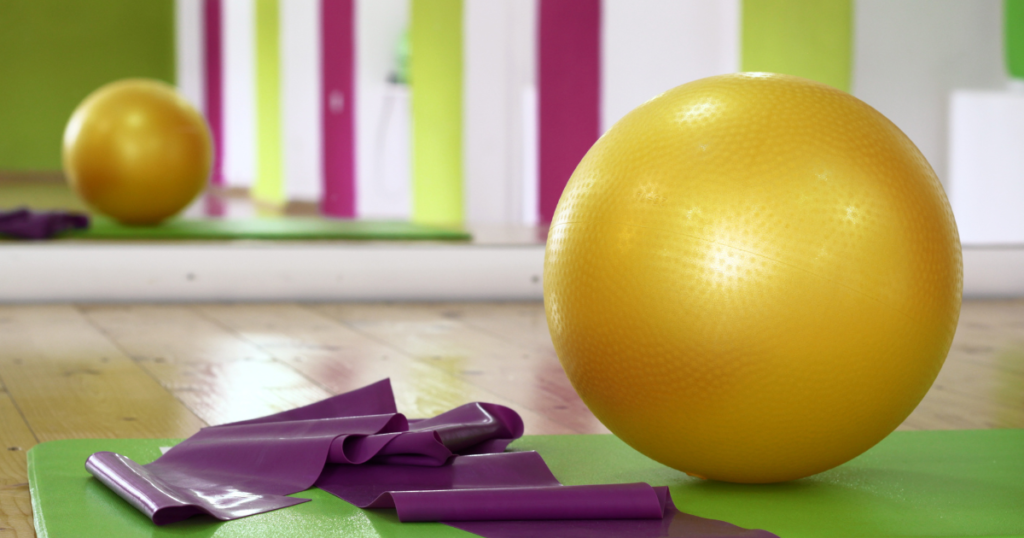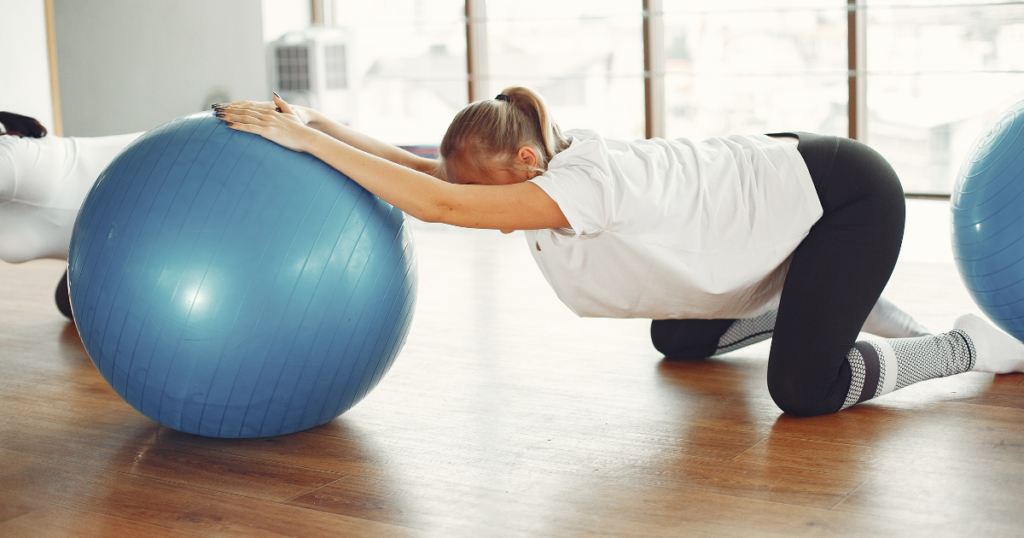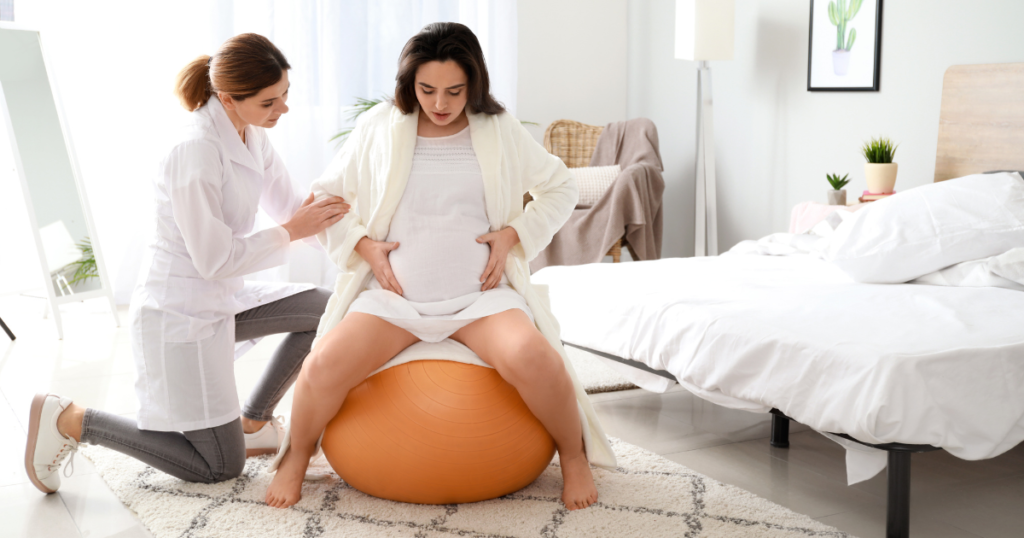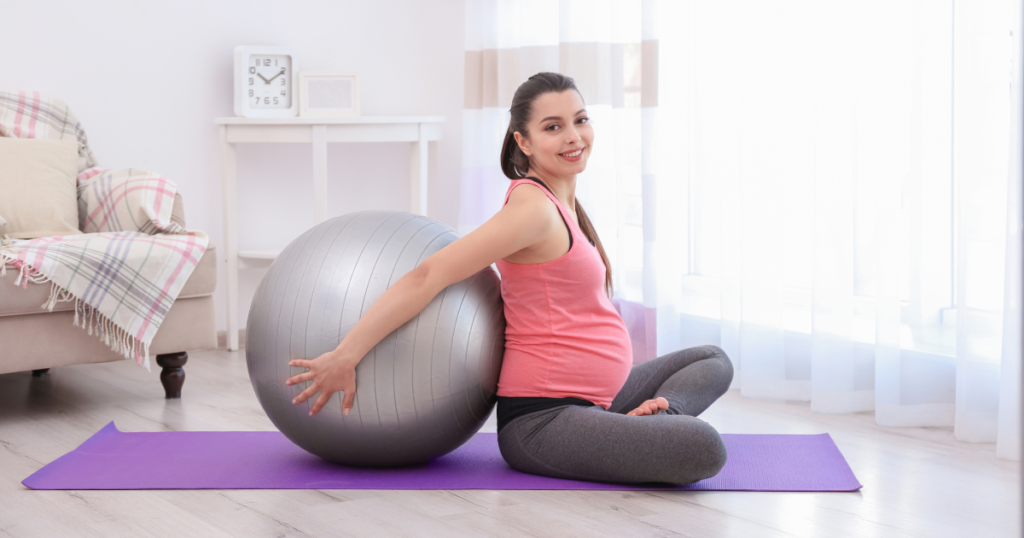Pregnancy is a transformative journey marked by physical changes and unique challenges. Expectant mothers often seek safe and effective ways to alleviate discomfort and maintain their well-being throughout this period. One increasingly popular option is incorporating a yoga ball into their prenatal fitness routine. However, choosing the right size yoga ball is crucial to ensure comfort, stability, and safety during exercises. This comprehensive guide will explore the benefits of using yoga balls during pregnancy, factors to consider when selecting the correct size, how to find the ideal fit, and safety precautions to follow.
By understanding these essential elements, expectant mothers can enjoy the numerous advantages of using a yoga ball while nurturing their health and well-being during pregnancy.
About Yoga balls

Yoga balls, also known as exercise or stability balls, are versatile fitness tools that offer a wide range of benefits for individuals of all fitness levels. These inflatable balls come in various sizes and are commonly used in yoga, Pilates, physical therapy, and general fitness routines.
The primary purpose of yoga balls is to improve balance, stability, and core strength. By engaging the body’s stabilizing muscles, such as the core, back, and pelvic muscles, yoga balls help enhance overall coordination and posture. Additionally, they can be used to perform various exercises targeting different muscle groups, including abdominal crunches, squats, and back extensions.
One of the unique advantages of yoga balls is their ability to challenge the body’s balance and proprioception, the sense of body awareness in space. This strengthens muscles and improves neuromuscular coordination, which can benefit activities of daily living and athletic performance.
Difference between a birthing ball and a gym ball
Although similar in appearance, a birthing ball and a gym ball serve different purposes and are designed with distinct features to meet specific needs.
A birthing ball, also known as a pregnancy or labor ball, supports expectant mothers during pregnancy, labor, and childbirth. These balls are typically made of anti-burst material and come in various sizes to accommodate different heights and body types. Birthing balls are often used during pregnancy to promote comfort, relaxation, and optimal fetal positioning. During labor, birthing balls can relieve pain and discomfort, facilitate movement, and help progress labor by encouraging pelvic mobility and opening the pelvis.
On the other hand, a gym ball, also referred to as an exercise or stability ball, is designed for general fitness and strength training purposes. Gym balls are commonly used in gyms, fitness studios, and physical therapy settings to improve balance, stability, flexibility, and core strength. They are typically made of durable, anti-burst material and come in various sizes to accommodate different body heights. Gym balls can be used for various exercises targeting multiple muscle groups, including abdominal crunches, squats, and back extensions.
Benefits of using yoga balls during pregnancy

Using yoga balls during pregnancy offers numerous benefits for expectant mothers, providing a safe and effective way to maintain fitness and alleviate discomfort. Here are some key advantages:
Promotes Proper Posture: Sitting on a yoga ball encourages proper spinal alignment, helping to alleviate strain on the back as the belly grows.
Strengthens Core Muscles: Engaging in yoga ball exercises, such as gentle bouncing or pelvic tilts, helps strengthen the abdominal and pelvic floor muscles, which are essential for supporting the growing uterus and preparing for childbirth.
Relieves Discomfort: The gentle bouncing or rocking motion on the yoga ball can relieve common pregnancy discomforts such as back pain, pelvic pressure, and swollen feet.
Encourages Circulation: Sitting or gently bouncing on a yoga ball promotes blood flow and circulation in the legs, reducing the risk of swelling and varicose veins.
Prepares for Labor: Certain exercises performed on the yoga ball, such as pelvic tilts and gentle bouncing, can help encourage optimal fetal positioning and facilitate a smoother labor process.
Supports Relaxation: Using a yoga ball for stretching or relaxation exercises can help reduce stress and promote relaxation, benefiting both the mother and the baby.
Factors to consider when choosing the right size yoga ball
When selecting the right size yoga ball for pregnancy, two primary factors should be considered: the pregnant woman’s height and weight and the ball’s level of comfort and stability.
- Height and Weight of the Pregnant Woman:
- Taller individuals may require a more giant yoga ball to maintain proper posture and stability during exercises.
- Similarly, heavier individuals may benefit from a more substantial ball to prevent it from compressing too much under their weight.
- Choosing the appropriate size based on height and weight ensures optimal support and effectiveness during prenatal workouts.
- Comfort and Stability:
- The pregnant woman should feel comfortable and secure while on the yoga ball.
- It should neither be too small, causing discomfort nor too large, compromising stability.
- Testing the ball for comfort and stability before purchase is essential to ensure a safe and enjoyable workout experience.
How to find the correct size yoga ball?
To find the correct size yoga ball for pregnancy, follow these simple steps:
- Measure Your Height: Use a tape measure to determine your height in inches or centimeters.
- Refer to Recommended Sizes: Match your height to the recommended yoga ball size:
- Under 5’4″ (163 cm): 55 cm ball
- Between 5’4″ and 5’10” (163-178 cm): 65 cm ball
- Over 5’10” (178 cm): 75 cm ball
- Test for Comfort: Sit on the yoga ball to ensure it feels comfortable and stable.
- Adjust if necessary: If the ball feels too small or large, consider sizing it up or down for optimal support.
- Confirm Fit: Ensure proper posture and stability while sitting on the ball to confirm the correct size.
How to use a yoga ball during pregnancy?
Using a yoga ball during pregnancy can be beneficial for maintaining fitness and comfort. Here are some ways to incorporate it into your routine:
Sitting Exercises: Sit on the yoga ball with feet flat on the floor and knees bent at a 90-degree angle. Engage your core muscles to maintain balance while performing gentle movements such as side-to-side sways or circles. This helps strengthen the core and improve posture.
Pelvic Tilts: Sit on the ball with feet hip-width apart and knees bent. Gently rock your pelvis forward and backward, tilting your hips up and down. This exercise strengthens the pelvic floor muscles, aiding labor and delivery.
Gentle Bouncing: While sitting on the ball, perform gentle bouncing movements by lightly lifting and lowering your hips. This low-impact exercise helps alleviate back pain, promotes circulation, and provides a soothing sensation for you and your baby.
Incorporating these exercises into your daily routine can help improve flexibility, strength, and comfort during pregnancy. Remember to listen to your body, avoid overexertion, and consult your healthcare provider before starting any new exercise regimen.
Can a birthing ball induce Labour?

While using a birthing ball, also known as a yoga ball, can help prepare the body for labor by promoting optimal fetal positioning and strengthening pelvic floor muscles, it typically does not directly induce labor. However, specific movements and exercises performed on the birthing ball, such as pelvic tilts and gentle bouncing, may sometimes encourage the progression of labor.
These movements can stimulate contractions and promote the dilation of the cervix by exerting pressure on the pelvic area. It’s essential to consult with a healthcare provider before attempting to induce labor with a birthing ball, as individual circumstances vary, and medical supervision is necessary to ensure safety for both the mother and the baby.
Safety precautions when using a yoga ball during pregnancy
Safety is paramount when using a yoga ball during pregnancy. Here are essential precautions to ensure a safe and effective workout:
Use on a Flat, Stable Surface: Always place the yoga ball on a flat, non-slip surface to prevent it from rolling or sliding during exercises. Avoid using the ball on uneven or prone-to-slipping surfaces, such as carpets or rugs.
Avoid Overexertion: Listen to your body and avoid pushing yourself too hard during workouts. Overexertion can lead to muscle strain or injury, particularly during pregnancy when your body is already undergoing significant changes. Start with gentle exercises and gradually increase intensity as your fitness level allows.
Consult with a Healthcare Provider: Before beginning any new exercise regimen, including using a yoga ball, consult your healthcare provider. They can provide personalized guidance based on your health status and pregnancy journey, ensuring that your exercises are safe and appropriate for you and your baby.
FAQs (Frequently Asked Questions)
What are the benefits of using a yoga ball during pregnancy?
Yoga balls promote proper posture, support pelvic floor muscles, relieve discomfort, and facilitate labor progression.
Can any size yoga ball be used during pregnancy?
No, it’s essential to choose the appropriate size yoga ball based on your height and weight for optimal comfort and stability.
How do I know if the yoga ball is the right size for me?
Measure your height and refer to recommended ball sizes. Sit on the ball to ensure comfort and stability.
Are there any exercises I should avoid when using a yoga ball during pregnancy?
Avoid exercises that strain the abdominal muscles excessively or pose a risk of falling.
Is it safe to use a yoga ball during all stages of pregnancy?
In most cases, yes, but it’s crucial to consult with your healthcare provider before starting any new exercise routine.
Conclusion
In conclusion, while birthing balls and gym balls may appear similar, they serve distinct purposes tailored to specific needs. Birthing balls provide crucial support and comfort during pregnancy, labor, and childbirth, aiding in pain relief, relaxation, and optimal fetal positioning. On the other hand, gym balls are versatile fitness tools primarily used for general strength training, balance, and flexibility exercises. Understanding the differences between these two types of balls allows individuals to make informed choices based on their specific requirements, whether it’s preparing for childbirth or enhancing overall fitness and well-being.
















